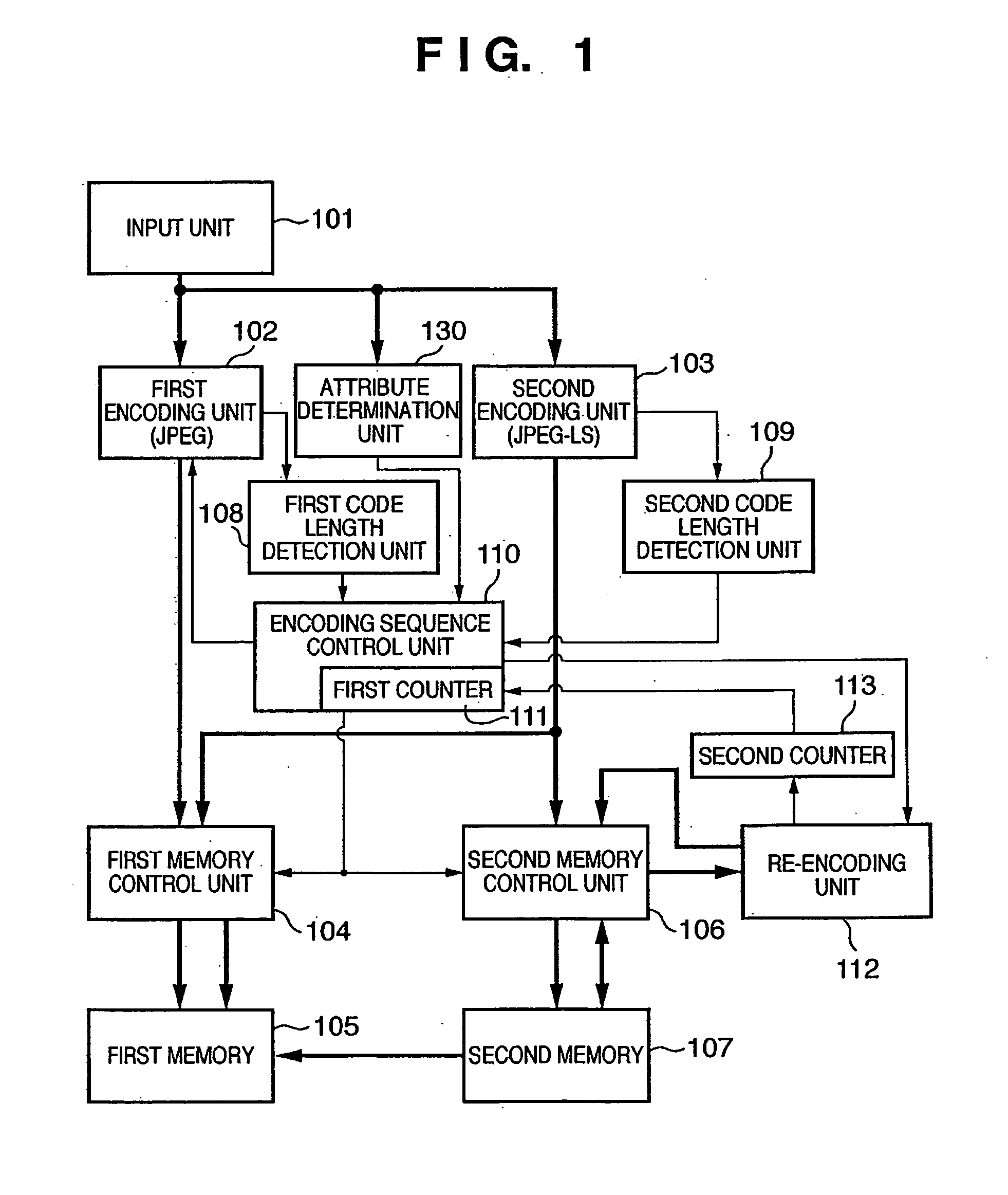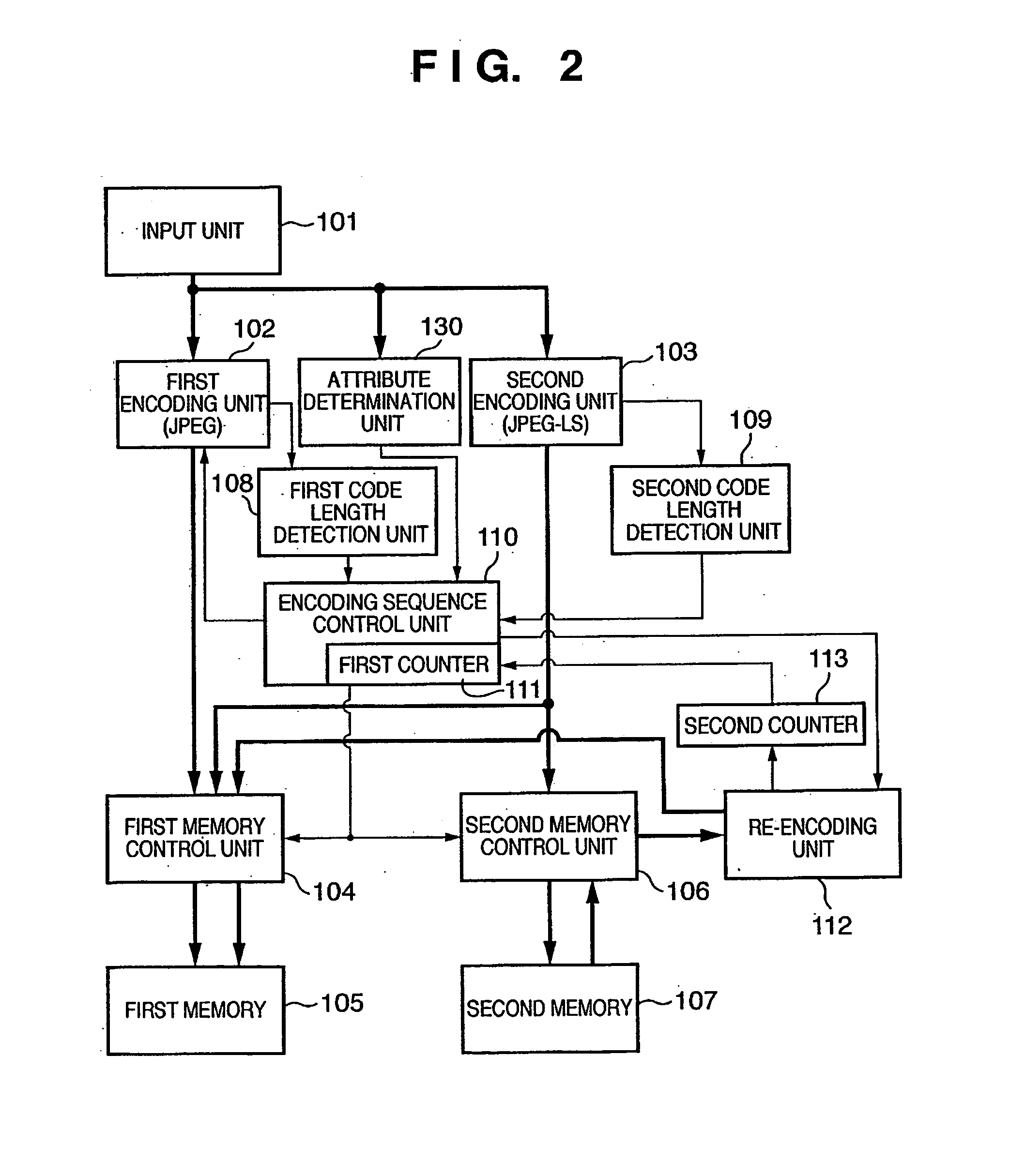Image encoding apparatus, control method therefor, computer program, and computer-readable storage medium
a technology of image data and control method, applied in the field of image data encoding, can solve the problems of document reading at least two times at poor efficiency, memory overflow, and difficulty in making encoded data of one image (document) fall within the target encoded data amount without pre-scan
- Summary
- Abstract
- Description
- Claims
- Application Information
AI Technical Summary
Benefits of technology
Problems solved by technology
Method used
Image
Examples
first embodiment
[0068]FIG. 1 is a block diagram showing an encoding unit 6 according to the first embodiment. Each unit in FIG. 1 will be briefly explained.
[0069] An input unit 101 incorporates a line buffer memory for a plurality of lines. As described above, the input unit 101 receives image data from a document reading unit 3 or rendering unit 4 via a selector 5 in the raster order, and stores the image data in the internal line buffer. The input unit 101 then reads out image data by a block of N×M pixels (in the first embodiment, a block of 8×8 pixels), and outputs the image data.
[0070] A first encoding unit 102 is a lossy encoding unit which compression-encodes each pixel block input from the input unit 101 in accordance with a parameter that influences the compression ratio, and outputs the result (encoded data). An identification bit representing that data has been encoded by the first encoding unit 102 is added at the start of the encoded data.
[0071] The image encoding unit 102 according...
second embodiment
[0197] In the first embodiment and the first to third modifications, when the number of colors in a pixel block serving as an encoding unit is equal to or smaller than a predetermined number, priority is given to lossless encoded data before the value of the first counter 111 exceeds a target data amount after the start of encoding one page.
[0198] This is convenient for lossless encoding JPEG-LS, but the present invention is not limited to only the number of colors.
[0199] In the second embodiment, lossless encoded data may be selected when the ratio at which white pixels occupy a pixel block (in the second embodiment, an area of an 8×8 pixel size) is equal to or higher than a predetermined value. Although the ratio is generally given by %, calculation is simplified by counting the number of white pixels because the total number of pixels is kept at 64.
[0200] Note that a white pixel is determined on the basis of R≈G≈B≈255 (each component is expressed by 8 bits).
[0201] The arrange...
third embodiment
[0207] The third embodiment will exemplify a case wherein an attribute determination unit 130 detects the number of white pixels in a pixel block (the ratio at which white pixels occupy a pixel block) and determines the character / line image attribute of the pixel block. The remaining arrangement can directly employ those in the first embodiment and the first to third modifications, and a description thereof will be omitted.
[0208] In general, a character / line image is characterized by a steep change in edge brightness (density). In determination of a character / line image, when a pixel of interest and an adjacent pixel have a predetermined brightness difference or more, the pixel of interest is determined as (the edge of) a character / line image. When there are a predetermined number of pixels which are determined to have a predetermined brightness difference or more, a pixel block of interest is determined as a character / line image block.
[0209] Determination of a character / line imag...
PUM
 Login to View More
Login to View More Abstract
Description
Claims
Application Information
 Login to View More
Login to View More - R&D
- Intellectual Property
- Life Sciences
- Materials
- Tech Scout
- Unparalleled Data Quality
- Higher Quality Content
- 60% Fewer Hallucinations
Browse by: Latest US Patents, China's latest patents, Technical Efficacy Thesaurus, Application Domain, Technology Topic, Popular Technical Reports.
© 2025 PatSnap. All rights reserved.Legal|Privacy policy|Modern Slavery Act Transparency Statement|Sitemap|About US| Contact US: help@patsnap.com



